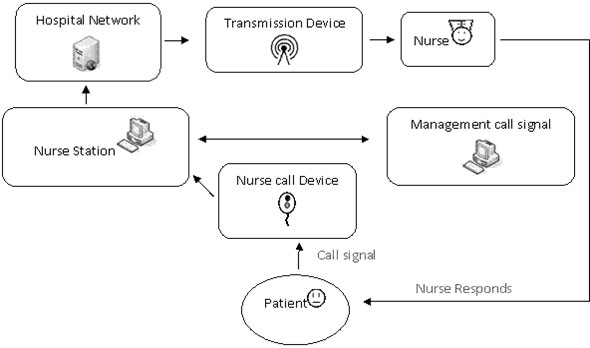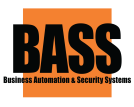Nurse call systems are an integral part of patient treatment and care. The systems alert nursing regarding patient needs and emergent situation. Timely response is the key to high quality patient care, which requires the minimization of redundancy in the entire nurse call workflow.
A typical nurse call system consists of five components:
- A central console
- A remote switching device for each patient or patient room
- Corridor or intermediate station lights
- Low-voltage power supplies
- Interconnecting wiring
The call can be initiated by patients or staff from any location with a “room station,” such as the patient’s bedside, bathrooms, or showers, as well as utility rooms and other areas.
In general all the Nurse call Systems operate under the same principle, the only variable is the level of complexity that each system can have.

Figure1. Diagram of a Nurse call system
The most common problem with nurse call systems is that cordsets at patient bedside stations break; they may also fail to signal the annunciator if they become disconnected. Breakage is typically caused by frequent use (especially those with television controls) or accidental dropping. However, cordsets are required by Underwriters Laboratories (UL) standards to signal the annunciator if a disconnection occurs (although systems have failed to do so on occasion).
Common Problems
Some nurse call systems use cordsets to transmit the call signal. This is a frequent failure point. The most common problem is that cordsets break at patient’s bedside stations; they may also fail to send the call signal if they become disconnected.
Cordsets that have the potential to generate an electric arc also could be potentially hazardous when they are used in or near oxygen-administering equipment such as oxygen tents. (They can be used with nasal cannulae). Systems that utilize pneumatic cordsets or pull cords rather than switches in the patient’s pendant can prevent this hazard.
There are several problems associated with infrared locator systems if they are part of a nurse call system. A caregiver’s transmitter badge may not be detected if the signal from the transmitter is physically blocked. This problem can be avoided with radio-frequency systems. Locator systems may also have trouble locating staff when a transmitter’s battery is low.
Common Features Of Nurse Call Systems
While modern nurse call systems can have many different features and options, perhaps the most common main components of a nurse call system are:
- Pillow speaker (or call light). This allows the patient to contact the nurse, as well as control the TV and overbed lights. Alternative breathe calls (for patients with limited movement or paralysis) can be plugged into the wall station; these let the patient contact the nurse simply by inhaling or exhaling into a particular tube.
- Wall station. This contains the microphone and speaker for communication between the nurse and patient. It also contains the code blue button and is the receptacle for the pillow speaker. IV pumps or ventilators can be connected to the nurse call station via the wall station, allowing alerts at the nurses stations whenever the connected equipment goes into alarm. This notifies the nurse to any equipment alarms more quickly than otherwise possible.
- Bed cable. It allows the patient bed to be connected to the wall station. When the bed alarm is set, this allows the staff to know if a patient that shouldn’t exit the bed is attempting to exit. It can also allow a patient to call the nurse’s station via a button on the bed rail.
- Desk console. The desk console is like a telephone (and looks very similar to a telephone); it allows the unit secretary or nurse to answer call from the patient or call into the patient’s room whenever necessary.
- Code blue. Code blue signifies a patient in need of immediate help. If a staff member presses the code blue button a group of alerts go off at the nurse’s station, as well as inside and outside of the room (and anywhere else where the nurse call system is set up to alert).
A functioning nurse call system is a lifeline between patient and medical staff. Visitors can use the nurse call system on the patient’s behalf, as well. Modern nurse call systems can have many different options and features for both patients and staff. It’s safe to say that things have come a long way from the 1800s, when a patient would ring a bell to get a nurse’s attention.

